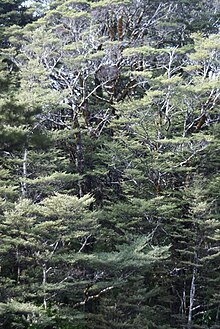Nothofagus cliffortioides
| Nothofagus cliffortioides | |
|---|---|

| |
| Mountain beech trees | |
| Scientific classification | |
| Kingdom: | Plantae |
| Clade: | Tracheophytes |
| Clade: | Angiosperms |
| Clade: | Eudicots |
| Clade: | Rosids |
| Order: | Fagales |
| Family: | Nothofagaceae |
| Genus: | Nothofagus |
| Subgenus: | Nothofagus subg. Fuscospora |
| Species: | N. cliffortioides
|
| Binomial name | |
| Nothofagus cliffortioides | |
| Synonyms[2] | |
| |
Nothofagus cliffortioides, commonly called mountain beech (Māori: tawhai rauriki), is a species of Southern beech tree and is endemic to New Zealand. Mountain beech grows in mountainous regions at high elevations. In New Zealand the taxon is called Fuscospora cliffortioides.[3][4] Nothofagus cliffortioides occupies a wider range of habitat than any other New Zealand tree species and it shows a corresponding range of life form, seeding habits, regenerative patterns, growth habits, growth rates, stand replacement and mortality patterns.[5]
Mountain beech grows to around 20 metres (66 ft)[6] but near the treeline forms a "goblin forest" where the trees are no more than 2 m (6 ft 7 in) tall. It also has leaves that are elongated and have a pointed end.
Ecology
[edit]Mountain beech is eaten by the mountain beech flat moth (Proteodes carnifex), and is a host plant for the lichens Yarrumia colensoi and Podostictina degelii, and the fungi Annulohypoxylon bovei Rossbeevera pachydermis.[7]
Hybrids
[edit]- Mountain beech is known to hybridise with black beech (Nothofagus solandri) where the two species co-exist, and in some places the hybrids may form complex introgressive hybrid swarms.[8]
- Mountain beech also hybridises with red beech (Nothofagus fusca) to form the hybrid species Nothofagus × blairii.[3]
References
[edit]- ^ Baldwin, H.; Barstow, M.; Rivers, M.C. (2018). "Nothofagus cliffortioides". IUCN Red List of Threatened Species. 2018: e.T96477403A96479960. doi:10.2305/IUCN.UK.2018-2.RLTS.T96477403A96479960.en. Retrieved 21 April 2023.
- ^ Nothofagus cliffortioides (Hook.f.) Oerst. Plants of the World Online. Retrieved 21 April 2023.
- ^ a b Heenan, Peter B.; Smissen, Rob D. (2013). "Revised circumscription of Nothofagus and recognition of the segregate genera Fuscospora, Lophozonia, and Trisyngyne (Nothofagaceae)". Phytotaxa. 146 (1): 131. doi:10.11646/phytotaxa.146.1.1. Retrieved 31 May 2015.
- ^ "Fuscospora cliffortioides (Hook.f.) Heenan & Smissen". Flora of New Zealand. Landcare Research 2010-2015. Retrieved 15 January 2016.
- ^ John Wardle (1969). Ecology of Nothofagus solandri (Black beech and mountain beech). University of Canterbury. Botany. OCLC 706454567.
- ^ "Mountain Beech Height". Details of our range of Beech variety. Southern Woods Nursery Ltd.
- ^ Hogan, C. Michael (ed.). "Nothofagus cliffortioides (Hook. fil.) Oerst". Encyclopedia of Life. Retrieved 21 April 2023.
- ^ "Fuscospora cliffortioides". New Zealand Plant Conservation Network. Retrieved 31 May 2015.
External links
[edit]Nothofagaceae (southern beech) species | |
|---|---|
| Nothofagus subgenus Fuscospora (genus Fuscospora Heenan & Smissen (2013)) | |
| Nothofagus subgenus Lophozonia (genus Lophozonia Heenan & Smissen (2013)) | |
| Nothofagus subgenus Nothofagus (genus Nothofagus Heenan & Smissen (2013)) | |
| Nothofagus subgenus Brassospora (genus Trisyngyne Heenan & Smissen (2013)) | |
| Nothofagus cliffortioides |
|
|---|---|
| Nothofagus solandri var. cliffortioides | |
| Fuscospora cliffortioides | |
| Fagus cliffortioides | |
Text is available under the CC BY-SA 4.0 license; additional terms may apply.
Images, videos and audio are available under their respective licenses.

